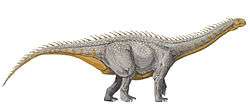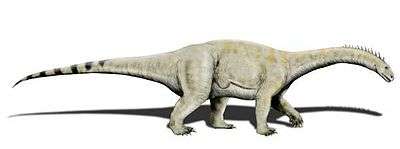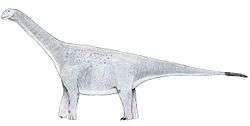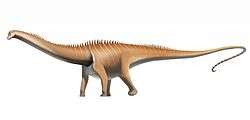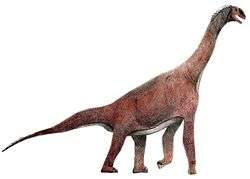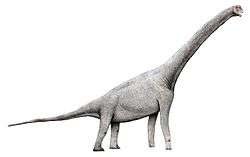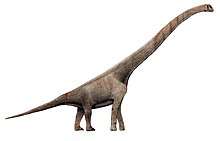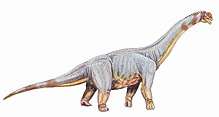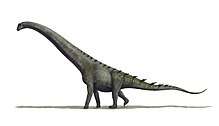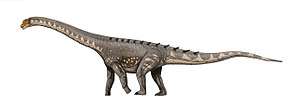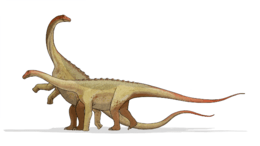Rapetosaurus
| Rapetosaurus | |
|---|---|
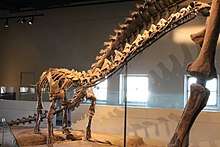 | |
| Juvenile skeleton, Field Museum of Natural History | |
| Scientific classification | |
| Kingdom: | Animalia |
| Phylum: | Chordata |
| Clade: | Dinosauria |
| Order: | Saurischia |
| Suborder: | †Sauropodomorpha |
| Clade: | †Sauropoda |
| Clade: | †Titanosauria |
| Family: | †Saltasauridae |
| Genus: | †Rapetosaurus Curry Rogers & Forster, 2001 |
| Species: | †R. krausei |
| Binomial name | |
| Rapetosaurus krausei Curry Rogers & Forster, 2001 | |
Rapetosaurus (/rəˌpeɪtuːˈsɔːrəs/ rə-PAY-too-SOR-əs[1]) is a genus of sauropod dinosaur that lived in Madagascar from 70 to 66 million years ago, at the end of the Cretaceous Period. Only one species, Rapetosaurus krausei, has been identified.
Like other sauropods, Rapetosaurus was a quadrupedal herbivore; it is calculated to have reached lengths of 15 metres (49 ft).
Description
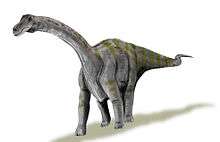
Rapetosaurus was a fairly typical sauropod, with a short and slender tail, a very long neck and a huge, elephant-like body. Its head resembles the head of a diplodocid, with a long, narrow snout and nostrils on the top of its skull. It was a herbivore and its small, pencil-like teeth were good for ripping the leaves off trees but not for chewing.
It was fairly modest in size, for a titanosaur. The juvenile specimen measured 8 metres (26 ft) from head to tail, and "probably weighed about as much as an elephant". An adult would have been about twice as long (15 metres (49 ft) in length)[2] which is still less than half the length of its gigantic kin, like Argentinosaurus and Paralititan.
Discovery and naming

The discovery of Rapetosaurus, known by the single species Rapetosaurus krausei marked the first time a titanosaur had been recovered with an almost perfectly intact skeleton, complete with skull. It has helped to clarify some difficult, century-old classification issues, among this large group of sauropod dinosaurs and provides a good baseline for the reconstruction of other titanosaurs that are known only from partial fossilized remains.
The discovery was published in 2001 by Kristina Curry Rogers and Catherine A. Forster in the scientific journal Nature. The nearly-complete skeleton is that of a juvenile and partial remains from three other individuals were also recovered.
The dig uncovered a partial skull (UA 8698, the holotype specimen), another partial skull, a juvenile skeleton missing only a few tail vertebrae, and an unrelated vertebra. The juvenile skeleton, in particular, is the most complete titanosaur skeleton ever recovered and the only one with a head still attached to the body.
The fossilized remains were found in the Mahajanga basin in northwest Madagascar, not far from the port city of Mahajanga. They were recovered from a layer of sandstone known as the Anembalemba Member, which is part of the Maevarano Formation. The rock formation has been dated to the Maastrichtian stage of the late Cretaceous, which means the fossilized bones are about 70 million years old. They were found by a field team from the State University of New York at Stony Brook with the assistance of the local Universite d'Antananarivo. The team leader, David Krause, had been excavating fossils from the site since 1993.
The generic name Rapetosaurus is derived from Rapeto (a giant deity in Malagasy folklore credited for the geographical features of the land[3]) and sauros, which is Greek for lizard. The species epithet, krausei, is named after the team leader of the expedition, David W. Krause.
Paleobiology
Growth

A rare specimen of a juvenile Rapetosaurus was uncovered in a museum collection by Kristina Curry Rogers and colleagues. The specimen was estimated to weigh about 40 kilograms (88 pounds) and was likely between 39–77 days old by the time of its death. At the time of its hatching, the juvenile Rapetosaurus was estimated to be 3.4 kilograms (7.8 pounds) in weight. Based on bone remodeling, the juvenile sauropod was also believed to have been capable of surviving with little to no parental care. Analysis of the bones further revealed the young Rapetosaurus likely starved to death due to Cretaceous Madagascar's harsh droughts.
Paleoecology
The Madagascar location has produced a large number of significant paleontological discoveries for Krause and his team. As well as dinosaurs, fossils of fishes, frogs, turtles, snakes, crocodiles, birds, and mammals have been unearthed. Significant finds include:
- The skull of Majungasaurus, a large abelisaurid theropod, was discovered in 1996. It is similar to species found in India and Argentina, which indicate that land bridges between the fragments of the former supercontinent of Gondwana still existed in the late Cretaceous, far later than was previously believed. The most likely occurrence was a land bridge allowing animals to cross from South America to Antarctica, and then up to India and Madagascar. Majungasaurus fossils have also been discovered with teeth marks that clearly come from the same species, making it the first dinosaur known to have practiced cannibalism.
- Masiakasaurus is a species of theropod with unusual teeth that stick straight out from its jaw.
- A variety of extinct mammals such as gondwanatheres and non-placental eutherians, the former reaching large sizes such as Vintana.
References
- ↑ Curry Rogers, K.; Forster, C.A. (2001). "The last of the dinosaur titans: a new sauropod from Madagascar". Nature. 412: 530–534. doi:10.1038/35087566.
- ↑ Montague, J.R. (2006). "Estimates of body size and geological time of origin for 612 dinosaur genera (Saurischia, Ornithischia)". Florida Scientist. 69 (4): 243–257. JSTOR 24321451.
- ↑ Zoë Crossland, Ancestral Encounters in Highland Madagascar: Material Signs and Traces of the Dead, Cambridge University Press, 17/02/2014
Sources
- Kristina Curry Rogers, and Catherine A. Forster. 2004. "The skull of Rapetosaurus krausei (Sauropoda: Titanosauria) from the Late Cretaceous of Madagascar". Journal of Vertebrate Paleontology, 24(1), pages 121–144. Abstract at BioOne
External links
- Paleontology News — Rapetosaurus from the Science Museum of Minnesota.
- Stony Brook Paleontologists Discover New Dinosaur and Name It in Honor of One of Their Own from SUNY-Stony Brook.
- New Dinosaur Species Found from Time for Kids Online.
- Skeleton of New Dinosaur "Titan" Found in Madagascar from National Geographic.
- Dino skull fills knowledge gap from the BBC.
- New Madagascar Dinosaur Discoveries from the T. Rex Museum.
- A press release, from the National Science Foundation, including a reconstruction (illustration).
